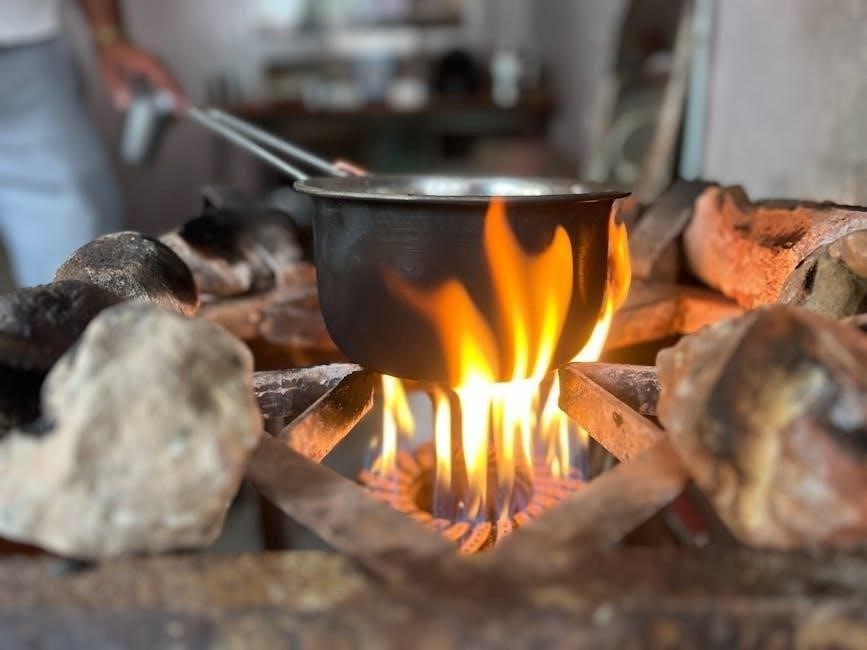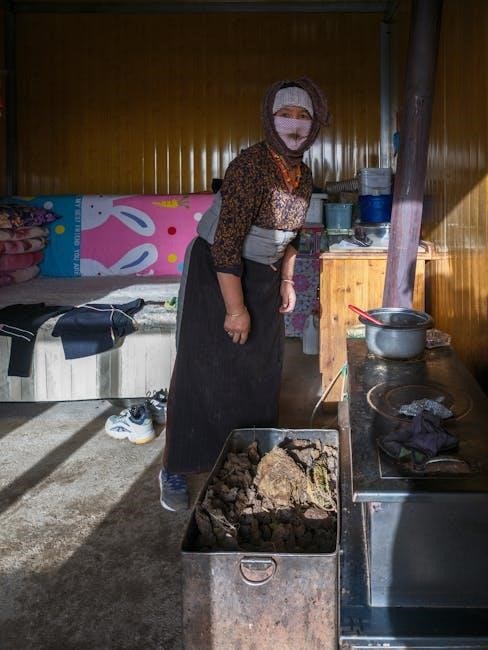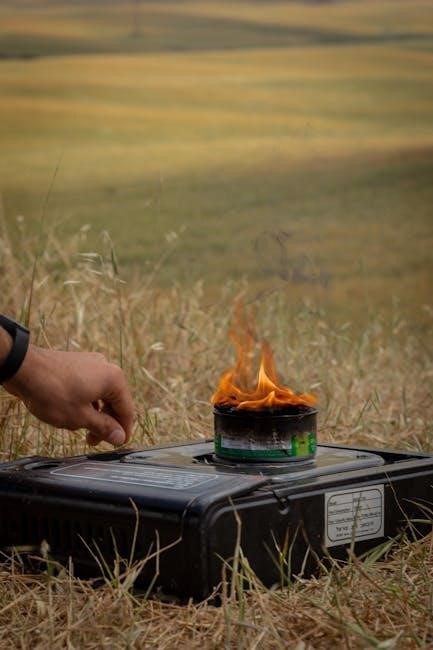Welcome to the Grand Teton Pellet Stove Manual. This guide provides essential information for safe installation, operation, and maintenance. Ensure optimal performance and eco-friendly heating by following the instructions carefully.

Overview of the Grand Teton Pellet Stove
The Grand Teton Pellet Stove is a high-efficiency, eco-friendly heating solution designed to provide reliable warmth with minimal environmental impact. It operates by burning compressed biomass pellets, offering a cleaner alternative to traditional wood stoves. The stove features a user-friendly interface, programmable thermostat, and advanced combustion technology to ensure consistent heat output. Its compact design makes it suitable for various spaces, while the large viewing window enhances the ambiance of a real fire. The stove is built with durable materials, ensuring long-lasting performance. With its energy-efficient design and low emissions, the Grand Teton Pellet Stove is an excellent choice for homeowners seeking a sustainable and cost-effective heating option. It combines modern technology with traditional comfort, making it a versatile and practical addition to any home.
- Eco-friendly and energy-efficient design.
- Advanced combustion technology for consistent heat.
- Programmable thermostat for precise temperature control.
- Durable construction for long-lasting performance.
- Large viewing window for enhanced ambiance.
Importance of Following the Manual
Adhering to the Grand Teton Pellet Stove Manual is crucial for ensuring safety, efficiency, and longevity of the appliance. Proper installation, operation, and maintenance procedures outlined in the manual help prevent potential hazards, such as carbon monoxide leaks or fire risks. Following the guidelines ensures optimal performance, maximizing heat output while minimizing fuel consumption. Additionally, adhering to the manual’s instructions preserves the product warranty, as deviations may void coverage. Safety precautions, such as clearance distances and venting requirements, are emphasized to protect both the user and the property. By following the manual, users can enjoy a reliable, eco-friendly heating solution while maintaining compliance with local regulations. Neglecting the provided instructions may lead to suboptimal performance, increased energy costs, or even dangerous operating conditions. Therefore, it is essential to thoroughly review and follow the manual for a safe and efficient heating experience.
- Safety: Prevents hazards like carbon monoxide leaks or fires.
- Efficiency: Ensures optimal heat output and fuel savings.
- Warranty: Non-compliance may void the product warranty.
- Environmental Impact: Reduces emissions and energy waste.
Key Features of the Grand Teton Pellet Stove
The Grand Teton Pellet Stove is designed for high efficiency and reliability, offering a robust heating solution for homes. It features a large hopper capacity, allowing extended operation without frequent refueling. The stove includes an advanced ignition system for consistent startups and a variable speed blower to distribute heat evenly. Its digital control panel provides easy adjustment of burn rates and heat output, ensuring precise temperature control. Constructed with durable materials, the stove is built to last, with a sleek design that complements various home decors. Additionally, it boasts low emissions, making it an eco-friendly choice. Safety features include automatic shut-off and a heat-resistant glass window for safe operation. The stove is also compatible with a wide range of pellet types, offering flexibility for users. These features combine to deliver a reliable, efficient, and environmentally conscious heating experience.
- Large Hopper Capacity: Extended operation between refuels.
- Advanced Ignition System: Consistent and reliable startups.
- Variable Speed Blower: Even heat distribution.
- Digital Control Panel: Precise temperature and burn rate control.
- Durable Construction: Long-lasting performance.
- Low Emissions: Eco-friendly operation.
- Safety Features: Automatic shut-off and heat-resistant glass.
- Flexibility: Compatible with various pellet types.
Installation Requirements
Proper location, suitable flooring, and professional installation are essential for safe and efficient operation. Ensure all local regulations and manufacturer guidelines are followed during setup.
Location and Placement Guidelines
Proper placement of the Grand Teton Pellet Stove is crucial for safety and efficiency. Choose a central location in your home to maximize heat distribution. Ensure the stove is installed on a level, non-combustible surface, such as ceramic tile or concrete, to prevent fire hazards. Keep the stove at least 3 feet away from flammable materials like curtains, furniture, or wood walls. Avoid installing it near windows or doors to minimize heat loss. The stove should also be placed in an area with adequate ventilation to ensure proper airflow for combustion. Consider the route for venting to avoid obstructions and ensure compliance with local building codes. Proper placement will enhance performance, safety, and overall heating efficiency.
Venting and Chimney Requirements
Proper venting is essential for the safe and efficient operation of the Grand Teton Pellet Stove. Use a venting system specifically designed for pellet stoves, as it differs from traditional wood-burning systems. The venting material should be durable, such as stainless steel, to withstand high temperatures and corrosive exhaust. Ensure the chimney is installed according to local building codes and manufacturer guidelines. The chimney height must be sufficient to provide adequate draft, typically extending at least 3 feet above the roof or nearby structures. Maintain proper clearance from combustible materials, such as 6 inches from walls and 8 inches from rafters. Regularly inspect the venting system for damage or blockages to ensure optimal performance and safety. Proper venting prevents carbon monoxide buildup and enhances the stove’s efficiency.
Clearance and Safety Distances
Proper clearance and safety distances are critical for the safe installation and operation of the Grand Teton Pellet Stove. Maintain a minimum of 3 feet of clearance from combustible materials, such as walls, furniture, and curtains, to prevent heat-related hazards. Ensure the stove is installed on a non-combustible surface, such as ceramic tile or concrete, to avoid fire risks. The stove must also be at least 8 inches away from any overhead combustible materials, like wooden beams or rafters. Always follow local building codes and manufacturer guidelines for specific clearance requirements. Proper spacing ensures efficient airflow and reduces the risk of overheating. Regularly inspect the area around the stove to maintain these safety distances and prevent potential fire hazards. Compliance with these guidelines is essential for both safety and optimal performance of the Grand Teton Pellet Stove.
Operating the Grand Teton Pellet Stove

Learn to operate the Grand Teton Pellet Stove safely and efficiently. Understand ignition, temperature control, and pellet management. Refer to specific sections for detailed instructions on daily operation and adjustments.
Starting the Stove for the First Time
Starting the Grand Teton Pellet Stove for the first time requires careful preparation to ensure safe and efficient operation. Begin by reading the manual thoroughly to understand the ignition process and safety precautions. Ensure the stove is properly installed, and all venting systems are securely connected. Before ignition, inspect the stove for any damage or blockages. Open the damper and ensure the chimney is clear. Place a small amount of pellets in the burn pot, following the manufacturer’s guidelines. Turn on the power and set the control to the “ignition” mode. The stove will automatically light the pellets. Monitor the flame and temperature, adjusting settings as needed. Allow the stove to run for a few hours to complete the initial burn-in cycle. Always follow the recommended startup procedure to ensure optimal performance and safety.
Controlling the Burn Rate and Heat Output
Controlling the burn rate and heat output of the Grand Teton Pellet Stove is essential for efficient and safe operation. The stove features an adjustable control panel that allows you to regulate the pellet feed rate and combustion air supply. To increase heat output, simply turn the dial to a higher setting, which will increase the flow of pellets and air. Conversely, reducing the setting will lower the burn rate and heat output. Always monitor the stove’s performance and adjust settings based on the type of pellets being used and the desired temperature. It is important to follow the manufacturer’s guidelines for optimal combustion and to avoid overloading the burn pot. Regularly cleaning the burn pot and venting system will also help maintain consistent heat output. Refer to the manual for specific instructions on adjusting these settings safely and effectively.
Monitoring and Adjusting Settings
Monitoring and adjusting settings on the Grand Teton Pellet Stove ensures optimal performance and safety. Regularly check the temperature, pellet feed rate, and combustion efficiency. Use the control panel to monitor real-time data and adjust settings as needed. Pay attention to error codes or alarms, which indicate potential issues. Adjust the pellet feed rate by turning the dial to increase or decrease heat output. Ensure proper airflow by checking venting and chimney connections. Use a thermometer to verify temperature levels and maintain a safe operating range. If adjustments are made, allow time for the stove to stabilize before further changes. Always turn off the stove before performing any manual adjustments. Refer to the manual for specific guidance on troubleshooting and resetting settings if necessary. Proper monitoring and adjustments will enhance efficiency, safety, and overall performance of the stove.

Maintenance and Upkeep
Regular maintenance ensures the Grand Teton Pellet Stove operates efficiently and safely. Perform routine checks on components, clean thoroughly, and address wear and tear promptly to prevent issues.
Daily Cleaning and Inspection
Daily cleaning and inspection are crucial for maintaining the efficiency and safety of your Grand Teton Pellet Stove. Start by turning off the stove and allowing it to cool completely. Remove ashes from the burn pot and firebox using a vacuum or shovel specifically designed for pellet stoves. Clean the heat exchanger and glass surfaces to ensure proper heat distribution and visibility. Check the hopper for pellet levels and ensure it is free from debris. Inspect the venting system for blockages or damage, as this is essential for proper airflow and safety. Look for signs of wear or damage on gaskets, seals, or other components. Regularly empty the ash pan to prevent buildup. By performing these tasks daily, you can ensure your stove operates efficiently and safely, reducing the risk of maintenance issues over time.
Weekly Maintenance Tasks
Weekly maintenance is essential to ensure the Grand Teton Pellet Stove operates efficiently and safely. Begin by cleaning the venting system, including the chimney and vent pipes, to remove any soot or debris buildup. Inspect the burn pot, heat exchanger, and combustion chamber for ash accumulation and clean them thoroughly. Check the gaskets and seals for any signs of wear or damage, replacing them if necessary. Lubricate any moving parts, such as the auger motor or fan bearings, to maintain smooth operation. Additionally, inspect the electrical components, including wires and connections, for damage or wear. Finally, ensure the pellet hopper is clean and free of debris, and verify that the pellets are dry and of high quality. Regular weekly maintenance helps prevent issues and ensures consistent performance throughout the heating season.
Annual Servicing and Inspection
Annual servicing and inspection are critical for maintaining the Grand Teton Pellet Stove’s performance and safety. Hire a certified technician to perform a comprehensive inspection of the stove and venting system. They will check for wear, damage, or blockages in the chimney, vent pipes, and combustion chamber. The technician will also clean the heat exchanger, burn pot, and other internal components to ensure proper airflow and combustion. Additionally, they will inspect and replace worn-out parts, such as gaskets, seals, and igniter elements, to prevent leaks or ignition issues. The pellet hopper and auger system will be cleaned and lubricated to maintain smooth operation. Finally, the technician will test the stove’s electrical and mechanical systems to ensure everything functions correctly. Regular annual servicing helps prevent breakdowns, improves efficiency, and ensures safe operation throughout the heating season.
Troubleshooting Common Issues
Identify and resolve common problems like ignition failure, error codes, or poor heat output. Refer to the manual for diagnostic guides and solutions to ensure optimal stove performance and safety.
Identifying Common Problems
Common issues with the Grand Teton Pellet Stove include ignition failure, error codes, and reduced heat output. These problems often stem from improper installation, faulty components, or poor maintenance. Ignition issues may arise from a malfunctioning igniter or insufficient airflow. Error codes, such as E1 or E2, typically indicate sensor malfunctions or communication errors within the stove’s control system. Reduced heat output could be due to clogged vents, incorrect pellet quality, or blockages in the burn pot. Regular inspection of components like the combustion chamber, heat exchanger, and venting system can help identify these issues early. Always refer to the troubleshooting section of the manual for specific guidance on diagnosing and resolving these problems. If issues persist, contact a certified technician to ensure safety and optimal performance.
Resolving Error Codes and Alarms
Understanding and addressing error codes is crucial for maintaining your Grand Teton Pellet Stove’s performance. Common error codes like E1, E2, or E3 often indicate specific issues such as ignition failure, sensor malfunctions, or communication errors. Start by powering off the stove and consulting the manual to identify the code’s meaning. For E1, check the igniter and ensure proper airflow. E2 may require cleaning or replacing sensors, while E3 could signal a control board issue. Reset the stove after addressing the problem. If errors persist, contact a certified technician. Regular maintenance, such as cleaning sensors and ensuring proper venting, can prevent recurring issues. Always prioritize safety and follow the manual’s troubleshooting guide to resolve alarms effectively.
When to Call a Professional
If you encounter issues beyond basic troubleshooting, it’s essential to contact a certified professional. This includes complex venting problems, recurring error codes, or damage to the stove or chimney. Professionals can diagnose and repair internal components, ensuring safety and efficiency. Additionally, if you’re unsure about installation requirements or clearance distances, seek expert assistance to avoid hazards. Annual servicing should also be performed by a qualified technician to maintain warranty validity and optimal performance. Don’t attempt repairs involving electrical or gas components, as this could lead to safety risks. Always prioritize your safety and the stove’s efficiency by consulting a professional when needed.

Safety Precautions and Guidelines
Always follow safety guidelines to ensure safe operation. Keep flammable materials away, maintain proper ventilation, and inspect the stove regularly. Adhere to manufacturer instructions to prevent hazards and ensure efficiency.
General Safety Tips
To ensure safe and efficient operation of your Grand Teton Pellet Stove, follow these essential safety tips:
- Keep flammable materials, such as curtains or furniture, at least 3 feet away from the stove.
- Ensure proper ventilation in the room to prevent carbon monoxide buildup.
- Never leave the stove unattended while it is in operation.
- Use only approved, high-quality pellets to maintain efficiency and safety.
- Keep children and pets away from the stove, as surfaces can become extremely hot.
- Regularly inspect the stove, venting system, and chimney for damage or blockages.
- Follow the manufacturer’s instructions for installation, operation, and maintenance.
- Install a carbon monoxide detector in your home for added safety.
By adhering to these guidelines, you can enjoy a safe and efficient heating experience with your Grand Teton Pellet Stove.
Venting and Carbon Monoxide Safety
Proper venting is critical for safe and efficient operation of your Grand Teton Pellet Stove. Always use a venting system specifically designed for pellet stoves, ensuring it meets local building codes and manufacturer specifications. Avoid using materials like PVC, as they are not suitable for high-temperature applications. Carbon monoxide safety is paramount; ensure your home has a working carbon monoxide detector installed on every level and near sleeping areas. Regularly inspect the venting system for blockages, damage, or corrosion, and clean it annually to maintain proper airflow. Never operate the stove if the venting system is compromised. Additionally, keep windows and doors slightly open to ensure adequate ventilation, especially during the first few hours of operation. By following these guidelines, you can minimize the risk of carbon monoxide exposure and ensure a safe heating environment.

Emergency Procedures
In case of an emergency with your Grand Teton Pellet Stove, follow these steps to ensure safety. First, turn off the power supply to the stove immediately. If the stove is producing excessive smoke or unusual odors, stop fuel supply and open windows for ventilation. Never use water to extinguish a pellet stove fire, as it can cause damage or electrical hazards. Instead, use a dry chemical fire extinguisher rated for electrical fires. Evacuate the area and call emergency services if the situation escalates. If carbon monoxide levels are suspected to be high, leave the premises and contact a professional to inspect the venting system. After an incident, do not restart the stove until it has been thoroughly inspected and cleared by a certified technician; Always prioritize safety and take prompt action to prevent further risks.

Environmental Impact and Efficiency

The Grand Teton Pellet Stove offers low emissions and high energy efficiency, making it an eco-friendly choice. It complies with environmental regulations, ensuring sustainable and cost-effective heating solutions.
Emissions and Eco-Friendliness
The Grand Teton Pellet Stove is designed with eco-friendliness in mind, producing low emissions that minimize environmental impact. By burning compressed biomass pellets, it significantly reduces carbon footprint compared to traditional wood stoves. The stove meets strict EPA standards, ensuring clean and efficient combustion. Its advanced technology minimizes particulate matter and harmful pollutants, making it a sustainable heating option. Additionally, the stove promotes the use of renewable energy sources, aligning with environmental conservation goals. Regular maintenance, as outlined in the manual, further ensures optimal performance and eco-efficiency. This makes the Grand Teton Pellet Stove an excellent choice for those seeking to reduce their ecological footprint while enjoying reliable heat.
- Low emissions for minimal environmental impact.
- Uses renewable biomass pellets as fuel;
- Meets EPA standards for clean combustion.

Energy Efficiency and Cost Savings
The Grand Teton Pellet Stove is highly energy-efficient, with a robust design that maximizes heat output while minimizing fuel consumption. Its advanced combustion system ensures that a high percentage of the fuel is converted into usable heat, reducing waste and lowering energy costs. By using dense, dry pellets, the stove achieves consistent and efficient burns, providing reliable warmth with less fuel. This efficiency translates to significant cost savings over time, especially when compared to traditional heating methods like oil or propane. Additionally, the stove’s programmable thermostat and automatic ignition allow for precise temperature control, further optimizing energy use. Regular maintenance, as outlined in the manual, helps maintain peak efficiency and ensures long-term savings. By choosing the Grand Teton Pellet Stove, homeowners can enjoy both environmental benefits and financial savings.
- High-efficiency combustion system for maximum heat output.
- Cost-effective compared to traditional heating methods.
- Programmable features for precise energy control.
Compliance with Regulations

The Grand Teton Pellet Stove is designed to meet strict environmental and safety regulations, ensuring eco-friendly and safe operation. It complies with emissions standards set by the U.S. Environmental Protection Agency (EPA), producing minimal pollutants and reducing its carbon footprint. The stove also adheres to safety certifications, such as those from Underwriters Laboratories (UL), guaranteeing reliable performance and user protection. By following the manual’s guidelines, homeowners can ensure the stove operates within regulatory requirements, maintaining both efficiency and safety. Compliance with these standards not only benefits the environment but also aligns with local and national regulations, providing peace of mind for users;
- Meets EPA emissions standards for reduced environmental impact.
- Complies with UL safety certifications for reliable operation.
- Adheres to local and national regulatory requirements.


